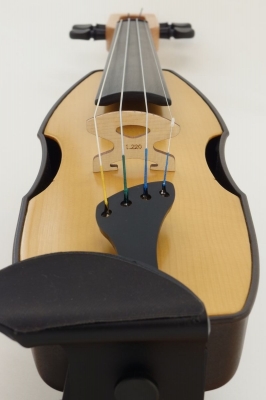Welcome to our forum. A Message To Our New and Prospective Members . Check out our Forum Rules. Lets keep this forum an enjoyable place to visit.
 Topic RSS
Topic RSS



 (6 votes)
(6 votes)  Offline
Offline
pretty much what it says in the title ... I have an old violin that's been laying around that I've been meaning to do some work on. It has a poorly repaired scroll crack, and the scroll is basically non-salvageable, so I was thinking of grafting on a whole new peg box that has enough room for more pegs, like a hardanger fiddle (hardingfele).
I know that hardanger fiddles are made with thinner wood, but how much of an effect does that have on the resonance of the sympathetic strings? My thought is that, if I hollowed out space in the neck so that the understrings could run under the fingerboard, and got a bridge like is on a hardanger (plus adding extra holes to the tailpiece etc etc, all the steps to adding like 5 extra strings), that there's no reason it shouldn't work ...
thoughts?
Regulars
 Offline
Offline








Regulars
 Offline
Offline








ClaireS - Curious, how your project is coming along?
Kinda surprised you haven't gotten a response from at least Irv or Peter.
I think a lot of the guys that have guitar backgrounds do more with EV's, not accoustic.
Do what you can to keep this thread fresh until someone can help you.
I was able to learn how to play Chanters Song from your video - Thank you! I suspect you might use a little ornamentation, but I couldn't quite be sure.
 - Emily
- Emily
Regulars
 Offline
Offline

@ClaireS and others. Violin necks have been historically reduced to the absolute minimum dimensionally to carry intended loads. Hollowing out the core to carry sympathetic strings (which, in turn, adds load) is a non starter unless you are talking carbon fibre or similar composite material.
An alternate would be to create a five string instrument similar to the one illustrated on the right hand side of the forum page. Unfortunately, a conventional instrument would need to have the existing peg locations plugged and new locations drilled and reamed. The cost, assuming that you do not possess magnificent diy skills, will likely equal the cost of a new (similar to the glasser carbon fibre 5 string) example.
Success is the progressive realisation of a worthy ideal. —Earl Nightingale.
 Offline
Offline
@Irv thanks for the input! the neck stability is definitely a concern. I've read a few articles from folks who have done regular violin to hardanger conversions, and it seems like generally as long as you keep the channel less than about 3/32" it seems to hold up. though I imagine that varies from instrument to instrument. if you scroll down to the second blog post at this link: http://hardangerfiddle.blogspot.com/ you can kinda see the channel they cut.
the joy is that since i spent all of about 30 bucks off craigslist for the fiddle, and the head is cracked anyway, i don't even feel bad about removing the old neck and messing around with a new one! I've wanted to work on some of my more delicate carving skills, and this seems like maybe a decent project to work on them with
@ELCBK - http://www.hfaa.org/Home/artic.....ardingfele you might find this link about alternate tunings interesting. I mess around a lot in AEae, ADae, and occasionally DDad .... but more strings means more tunings (and more fun?)
Regulars
 Offline
Offline

@ClaireS and others. The blog pictures were most helpful in sensing what you want to do. It looks like the auxiliary strings are of a very light gauge, which should not create much additional load on the neck (and the channel for them in the neck is very shallow). Let me give you some preliminary ideas and we can augment them as needed.
The fingerboard needs to be removed from the violin. If the fingerboard is ebony, you will need a clothes iron and a metal spatula. Employ a yt video for technique or ask directions here.
A dremel tool with a router attachment can be employed to create the auxiliary string channel. If you want to get fancy with a carbon fibre truss rod, you can use the same tool for that.
I think that by doubling the wire though the hole in the tuner, and using a pin at the tailpiece instead of a ball end insertion hole, you could limit the number of auxiliary tuners to two. That will free up a lot of area in the peg box.
I would ask the blogger what brand of ukulele tuner they used. A Violin pegbox is not as thick as a ukulele peg head. Not a big deal since a wood bushing could be used to make up the distance.
it looks like there is a small nut used to align the auxiliary strings (see photo).
I would use a different design of bridge to free up area for the auxiliary strings to pass through. I will post a picture.
The violin pictured in the blog had two vent holes in the upper belly bout. Do you want this as well?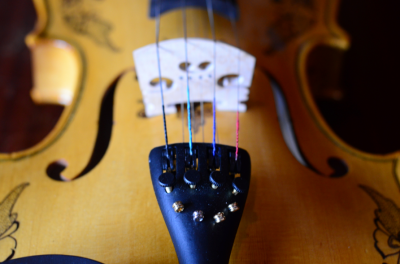

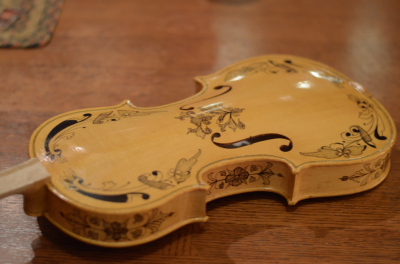

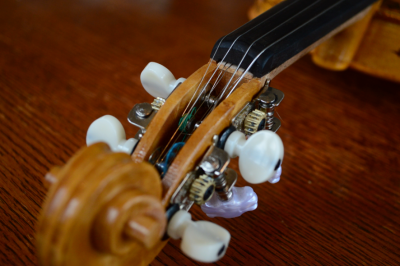

Success is the progressive realisation of a worthy ideal. —Earl Nightingale.
Regulars
 Offline
Offline

Regulars
 Offline
Offline








ClaireS -
The link for the violin conversion to Hardanger is super cool! I was concerned about the peg box, but they have a great solution! Bummed I couldn't access the early photos.
So, you going to carve the channel on a new neck? If so, could you set up a jig to use a router table? I've done woodworking and some carving, but I prefer my rotary Foredom with a flexible shaft. My BH just recommended a "stock maker's inletting tool" (gunsmith), but I'm thinking that channel is so shallow/flat - are you familiar with small "shoulder planes" (5/8" is smallest)? I've seen a 15mm luthier's plane - the blade is at the end instead of underneath the middle - blade runs the complete width on both styles. Are you going to use a padded vise to hold the neck while you chisel/file the channel, or something special for luthiers?
I'm getting carried away again...
I saw some pretty cool Hardanger bridge designs online!
My last question - why is everyone so afraid of using animal hide glue?
I used to go through a lot of it, not for gluing wood but for "glue-chipping" glass. I used to adjust strength and amount applied to get several different patterns from a sandblasted surface. But, then I had to control humidity & drying...
If you know the strength to mix, let the granules set in cold water until all is absorbed (I used to use different sized pyrex measuring cups) then just microwave it carefully at like 50% pwr (keep covered w/plastic wrap) until melted, check for desired temp. Just don't stir more than you can help (& slowly) because you don't want bubbles. Obviously you don't want it to boil, but you don't need a fancy "glue pot". Extra can be stored covered in the fridge for only a day or so (watch for mold), then reheated.
Thanks for the Hardanger tuning link - I only had the Swedish/Norwegian fiddle tunings link I posted in the other thread.
Geez, sorry Claire, I've really been rambling. You can just show some photos when you get done. Good luck!
- Emily![]()
Regulars
 Offline
Offline

@ClaireS and others. Check out the planetary ukulele tuners made by gotoh. They are well made and create the leverage needed to keep the auxiliary strings from loosening.
If geared tuners were used on the violin strings, there would be no need for fine tuners on the tail piece. If the ball ends of the “g” and “e” strings were inserted into tail piece inverted (as if the auxiliary strings in the picture), it may be possible to use the hole in the center of the ball end to loop around the auxiliary string. Some back and forth may be required for precise tuning, but due to the tension differential this should not be too troublesome.
Success is the progressive realisation of a worthy ideal. —Earl Nightingale.
 Offline
Offline
Thanks for all the advice! This is great!
First off, the violin came with some funky tuners to start with. here's a picture: 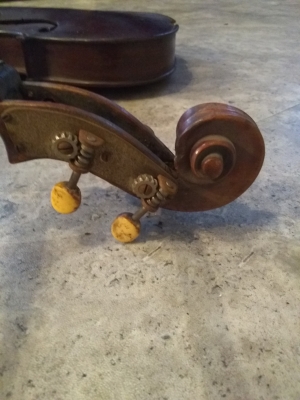

I think if I can figure out a way to just use them, it'll save me some time and effort - but the fact that they're mounted on a metal plate means to get other peg holes reamed, I would need to also go through that metal plate. which I'm not super keen on. So it may honestly be easier to just get some sort of uke tuners like you suggested.
I have the fingerboard off, and am going to have to put a whole new fingerboard on it as this is how it looked when it came to me: 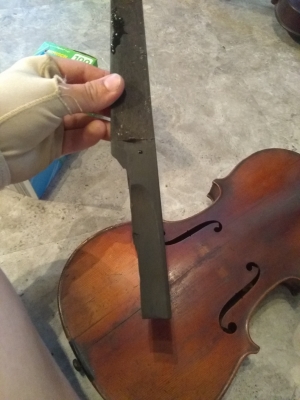

I have a fresh fingerboard I'll need to plane and fit ... when I get a chance.
I like the look of that alternate style violin bridge. I also found some places online you can just buy blank hardanger bridges. I've recently been working on bridge carving and fitting, so I may try one of those just for the practice.
In about two months I'll be out of my studio apartment and into a house - where I'll finally have space to spread out and actually be able to work! So I'll probably wait to get started on the routing, etc until then. I'm very much in the planning stages lol
@ELCBK - I have a bottle of Titebond liquid hide glue that I use for instrument repairs, since I didn't feel like messing with the granulated glue and heating it up (and inevitably making a bit of a mess.....) in my little apartment. Something to try out in the future for sure!
Regulars
 Offline
Offline








Regulars
 Offline
Offline








ClaireS - ran across this other option for your tail piece, but with fine tuners for your sympathetic strings. If you choose to do this, I would be sure to use locking nuts/washers because of vibration.
http://lostbiro.com/blog/?p=1112
 - Emily
- Emily
1 Guest(s)


 Log In
Log In Register
Register






